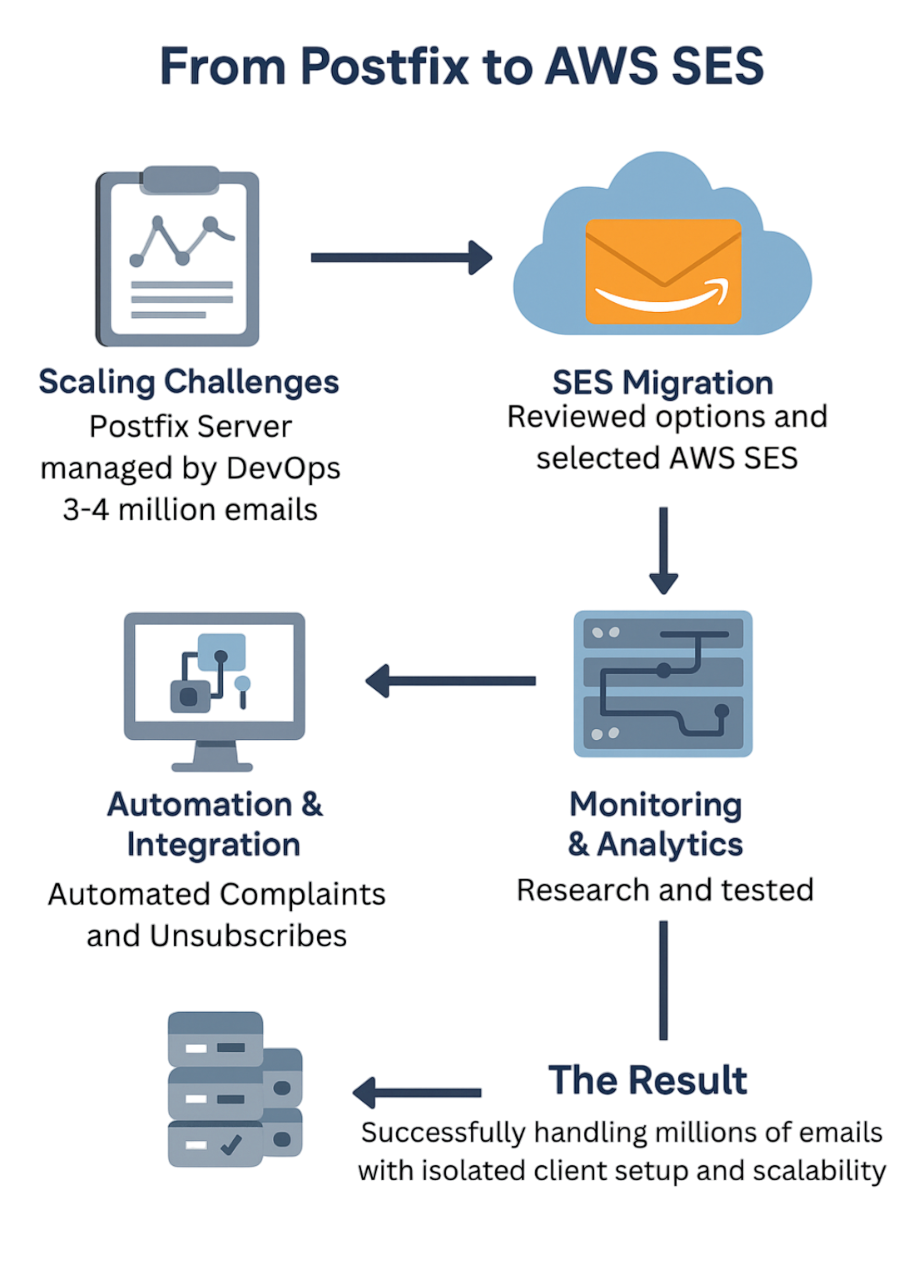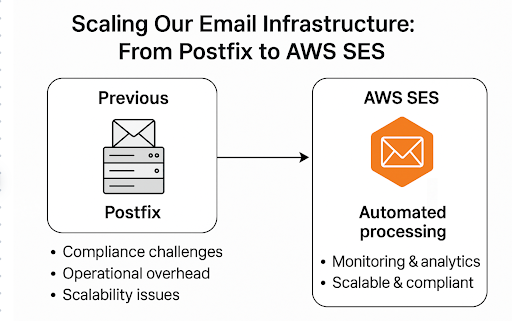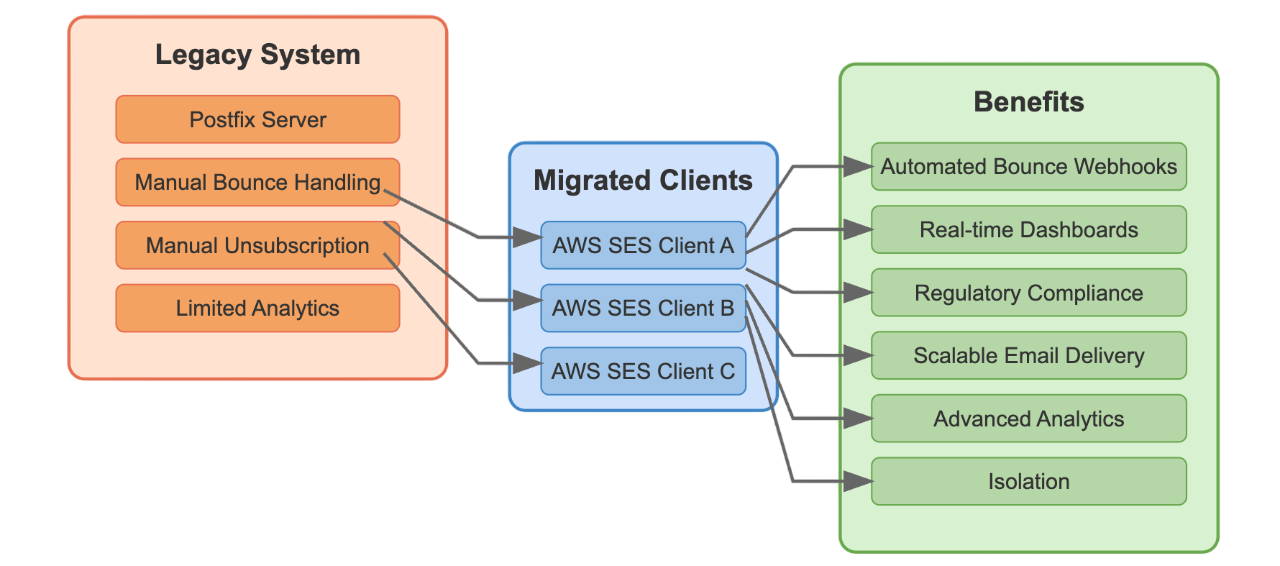
While our Postfix setup on cloud server was well-tuned and could reliably handle 3–4 million emails monthly, we began experiencing issues with mailing services not from raw delivery volume, but from the complexity introduced by compliance, client separation, and maintenance overhead.
Previously, unsubscribe requests and complaint notifications were routed to a shared mailbox, where a scheduled job would periodically parse and process them. While functional, this approach lacked the robustness and scalability required for long-term growth.
As we scaled to manage email delivery for tens of clients through a Postfix instance, it became increasingly clear that this setup was not sustainable. Centralizing complaint handling in a shared inbox introduced latency, risk of missed signals, and operational overhead.
To ensure compliance, improve deliverability, and provide better visibility across client accounts, we needed a more systematic and resilient solution, one that could reliably handle feedback loops, automate unsubscribe workflows, and scale with demand.
If one client’s mail triggered spam complaints or got blacklisted by providers like Microsoft or Google, it put at risk the IP reputation for all clients. This meant:
- Deliverability issues rippled across otherwise healthy domains.
- Recovery required hours of diagnosis, reconfiguration, and provider negotiation.
- Microsoft could silently block an IP, affecting every user on the shared Postfix
This lack of tenant isolation was no longer sustainable as we scaled.
Staying GDPR compliant wasn’t a one-time setup. We had to constantly:
- Monitor Google and Microsoft’s evolving sender guidelines for mail servers
- Manually enforce unsubscribe mechanisms, list hygiene, and privacy policies
- React to policy updates across providers (TLS requirements, header policies)
This turned compliance into a moving target, with every update placing a new workload on our internal DevOps team.
Why We Shifted Gears
It wasn’t just about infrastructure limits. We realized we needed:
- Better automation for complaint handling and unsubscribing
- More reliable delivery analytics and bounce tracking
- Easier compliance with industry regulations like CAN-SPAM and GDPR
- The ability to scale without rebuilding infrastructure
- Requirement of isolation between clients
We evaluated multiple options, balancing flexibility, performance, cost, and support. After thorough research and initial testing, Amazon Simple Email Service (SES) stood out as the best solution for our needs.
The Migration Journey
Migration wasn’t just about flipping a switch. It was a multi-phase process that required deep integration across our stack:

Planning & Risk Management
We started by understanding SES’s sending model, verifying domains, and setting up proper IAM policies. We evaluated risks around IP warm-up, deliverability, and regional SES availability.
Automation & Integration
With Amazon SES, many of those challenges are either abstracted or automated:
- Bounce, complaint, and unsubscribe handling via webhook
- Dedicated dashboards for analytics and delivery insights
- Compliance mechanisms like DKIM, SPF, TLS, and domain verification are built-in and regularly updated
- Each client can be segmented logically. No shared IP contamination risk.
Monitoring & Observability
We built dashboards and alerting systems for bounce/complaint rates, using CloudWatch and SNS. This gave us real-time insights and made it easy to take corrective actions before problems scaled.
Performance & Analytics
With SES, we gained granular statistics—delivery, opens, click-throughs—and could track and segment our campaigns with far greater detail than before.
What We Learned
- Postfix is powerful but maintaining it at scale while staying compliant is a full-time job.
- SES offers reliability and peace of mind, especially when email isn’t your core product but must be done right.
- Automation is key to managing volume. Without it, you're just chasing issues.
- Monitoring bounces and complaints is not optional; it's central to reputation management.

The Result
Today, we have a system that:
- Scales seamlessly with our platform and customer growth, without manual reconfiguration or capacity bottlenecks.
- Reliably handles millions of messages per month with isolated domains and dedicated tracking.
- Maintains compliance automatically, adapting to evolving regulations like GDPR, CAN-SPAM, and provider-specific requirements (Microsoft, Google)
- Improves deliverability by segmenting senders, reducing cross-client risk, and managing bounces and complaints in real-time
- Frees our DevOps team from maintenance firefighting and allowing us to focus on building, not babysitting infrastructure
This migration wasn’t just an infrastructure shift, it was a strategic move to future-proof how we communicate at scale.